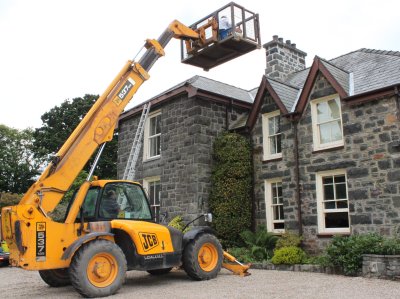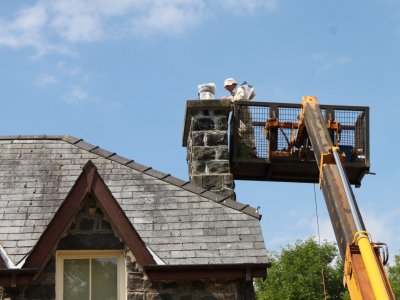

David Heaf's Honey Bee Relocation Pages
David Heaf undertakes honey bee rescue and relocation
assignments in Gwynedd, North Wales.
Contact email address: david (at) dheaf (dot) plus (dot) com (please
reconstruct this anti-spam email address; format: text@text.plus.com)
Phone: 5 2 3 1 8 1 (Code: 0 1 7 6 6)
Other swarm collectors: Essex; Somerset


Removing swarms of honey bees
Swarms are relatively easy to remove. Examples of what swarms look like can be found here. Pictures of honey bees compared with other similar insects can be found here. A swarms (a cluster of bees usually between a tennis ball and a foot ball in volume) hanging out in the open, e.g. on a tree or building, will most often depart of their own accord to a suitable cavity. However, as this could be in a building, it is helpful if the bees are collected and hived by a beekeeper before the swarm departs from the place where it has temporarily landed.
Removing established feral colonies of honey bees
Contrary to common belief, honey bees are not a legally protected species. When they establish themselves in buildings, it is the health and safety of the human occupants that takes precedence over that of the bees. Consequently, if a colony cannot be removed alive, or if the cost of doing so is beyond the building owner's means, then the colony can be killed.
If bees are killed with insecticides, a method commonly adopted even by a well known pest control company, there is a big risk that the insecticide will be transferred to the honey in the nest. When robber bees come from neighbouring colonies to rob out the poisoned honey, including from those colonies belonging to beekeepers, the poison could kill the colonies to which it is being taken. This would be a big economic loss to the beekeepers concerned, and, if proof could be found regarding the source of the poison, the pest controller could incur a fine for improper use of an approved pesticide. Example.
If you opt for poisoning a colony, make sure it is carried out by a technician who abides by the National Pest Technicians Association's Code of Practice Relating to the Control of Feral Honey Bees .
A honey bee colony can be killed quickly by a competent technician by flushing the cavity with CO2 gas. This leaves no pesticide residues. Another residue-free method is to burn sulphur. This requires the cavity to be free of combustible materials, e.g. a chimney.
The methods described below are mainly for those not wishing to destroy the colony. The two alternatives are 'cut outs' and 'trap outs'.
Cutouts: Unless the colony is on comb in the open, cutouts require easy access to the cavity with the colony and thus require a certain amount of dismantling the structure surrounding the cavity, which in most cases is a building. Cutouts can usually be completed in a few hours. After exposing the colony, the bees may be taken live into a bee vacuum and the combs removed one by one. In circumstances of easy access the combs may be supported in frames and the bees reunited with them. In which case, even if the queen is not caught in the process, the bees can raise a new queen from eggs in the comb.
Trapouts: Trapouts are preferred where no dismantling is possible, but can take six weeks to completion and require all entrances to be sealed but one. In a trapout a bee escape is sealed to the entrance. Foragers exit but cannot return. A hive with some old comb in it, and possibly some lemon grass oil, a pheromine substitute, is mounted next to the escape. The trapped out bees enter. In a day or two a comb containing eggs is inserted in the hive. The trapped out bees, whose numbers are ever increasing as more bees hatch out in the parent colony in the wall, raise a new queen. She mates and starts laying in the hive. Cutting off the food and water supply to the parent colony causes the queen there to stop laying. Eventually the colony is extremely depleted of bees and the queen dies. This could take about six weeks. The final phase involves removing the bee escape. Bees in the hive with the new queen rob out the honey from inside the wall, so there is no risk of slicks of honey ruunning against internal walls as abandoned comb degrades. When robbing out is complete, the hive is removed to an apiary.
Preventing re-infestation
Once a honey bee colony has been in a cavity, that cavity is even more attractive to bees in the future. It is therefore essential to make the cavity insect proof. Where it is a disused chimney, it can be capped with a vented cap that includes an insect barrier. For more details, please see my page on insect-proofing chimneys.
Examples of trapouts
Chimney (small swarm as a lure): http://bindaree.com.au/hints/removing-bees-from-a-chimney/
Chimney (recently occupied by swarm, 2009): chimney_swarm_tynewydd.htm
House wall using queen-right nuc as lure: http://beehuman.blogspot.com/2009/04/trap-out-illustrated.html
Concrete block wall http://forum.beemaster.com/index.php?topic=23518
Trapout of a small colony in a wall (with link to a video) http://learningtobeenatural.wordpress.com/tag/trap-out/
Trevor Ray's trapout of a new colony in a slate roof (2012) http://kungfu23.myzen.co.uk/Warre_Photos/Trapout.html
Examples of cutouts
Colony in the open (queen caught and run onto framed comb; cut combs simply propped up in brood box for brood to hatch) http://www.stratfordbeekeepers.org.uk/PENotes/WildColonies.htm
Colony in a well house (transfer to top-bar hive using cotton strips for comb 'hammocks') : http://bees.taroandti.com/2008/06/09/second-cutout/
Swarm cutout: http://www.culturedhome.com/2010/06/30/a-successful-honey-bee-swarm-cut-out/
Chimney swarm Pentrefelin (2009)
Bee vacuum used on swarm (Aug 2009)
Established colony in the flat roof of a garage (June 2010)
Flat roof of a nursing home (April 2011)
South Pwllheli chimney (June 2011)
Yr Ala Pwllheli soffits (July 2011)
Arg Abersoch chimney (July 2011)
Brynsiencyn chimney (July 2011)
Llanfrothen chimney (July 2011)
Morfa Bychan holiday chalet soffits (2012)
Criccieth hotel ventilation duct (April 2014)
Pentrefelin flat roof cavity (May 2014)
Llanbedrog long established colony (July 2014)
Criccieth compost bin (April 2015)
N-y-G soffit cutout (April 2015)
Plas Gwyn flat roof (June 2015)
Garndolbenmaen eaves swarm newly arrived (July 2015)
Farmhouse flat roof (July 2015)
Gable end rafters and attic (October 2016)
Examples of trapins
This is sometimes an option where there is only one entrance and the owner does not want a trapout done. It results in the death of the colony in situ and could cause problems due to honey seepage.
Examples of smoking-out colonies (used in chimneys only)
Honey Bee Colony in a Rectory Chimney